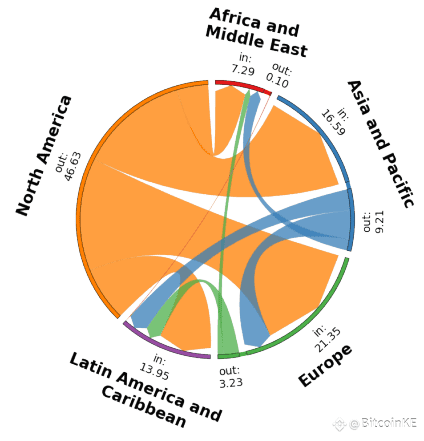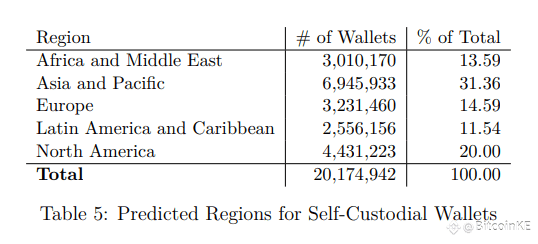A new IMF working paper (Decrypting Crypto: How to Estimate International Stablecoin Flows, July 2025) reveals that Africa and the Middle East have one of the highest levels of stablecoin usage globally – equivalent to 6.7% of GDP in 2024.
The paper also highlights the more popular stablecoins in Africa saying:
“Tether’s USDT is more popular in regions with more emerging economies – Africa and the Middle East, Asia and the Pacific, and Latin America and the Caribbean – while Circle’s USDC is more prevalent in regions with more advanced economies, i.e., Europe and North America.
Regarding crypto exchanges, we find that Binance is preferred in emerging market regions, whereas Coinbase leads in North America.”

Key Africa Highlights from the Report:
Volume: Estimated $200B+ in stablecoin flows, with USDT dominating transactions (57% share) over USDC (43%).
Use Case: Most activity was cross-border, not domestic – just 14% of flows stay within the region, pointing to remittances, trade settlement, and capital flows as the main drivers.
Average Transaction Size: $13,108, far lower than in advanced economies, reflecting smaller-value, high-frequency transfers.
Exchange Preference: Binance leads overwhelmingly, handling 74% of Africa’s CEX-linked stablecoin volume.
Global Context: Only Latin America & the Caribbean (7.7% of GDP) surpass Africa in stablecoin usage relative to economic size.

The IMF notes that Africa’s reliance on stablecoins underscores their role as a dollar substitute in markets with volatile local currencies, high remittance costs, and limited access to USD through traditional banking.
Net flows into Africa largely originate from North America, which the report says is the “primary exporter” of stablecoins to meet global dollar demand.
Africa’s stablecoin activity has grown despite global market volatility, suggesting strong underlying utility beyond speculation.
Data Set
The IMF dataset spans the entire history of stablecoins up to the end of 2024, but this section focuses specifically on 2024. We begin with an overview of key statistics before moving into detailed breakdowns.
In 2024, we mapped approximately 138 million stablecoin transactions worth a total of $2.019 trillion, with an average transaction size of $14,630. These transactions involved 14.6 million wallets — 10.4 million tied to centralized exchanges and 4.2 million self-custodial wallets.
Breaking down the total volume:
$309 billion flowed entirely between self-custodial wallets
$1.141 trillion flowed between self-custodial wallets and centralized exchanges
$569 billion flowed between centralized exchanges
Self-custodial wallets are especially important to track – they appear in at least one side of 72% of stablecoin transaction volume.
Regional patterns vary significantly. USDT dominates in emerging market regions (Africa & Middle East, Asia & Pacific, Latin America & Caribbean), while USDC is more common in advanced economies (Europe, North America). Transaction sizes also differ: North America records the largest average transaction size at $35,016, while Asia & Pacific has the smallest at $11,493. Notably, stablecoin flows display fat tails, with averages often far above the median.
[TECH] REPORT | Stablecoins Now Account for 43% of All Sub-Saharan Crypto Transactions, Says Quidax: Africas cryptocurrency journey has evolved far beyond retail speculation. What started as a hedge against .. https://t.co/T3wujg2Dhp via @BitcoinKE
— Top Kenyan Blogs (@Blogs_Kenya) August 11, 2025
Stay tuned to BitKE for deeper insights into crypto use cases in Africa.
Join our WhatsApp channel here.
Follow us on X for the latest posts and updates
Join and interact with our Telegram community
___________________________________________

